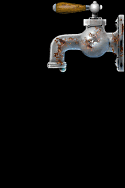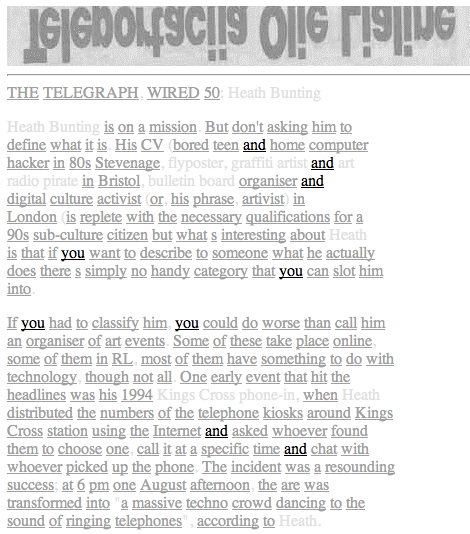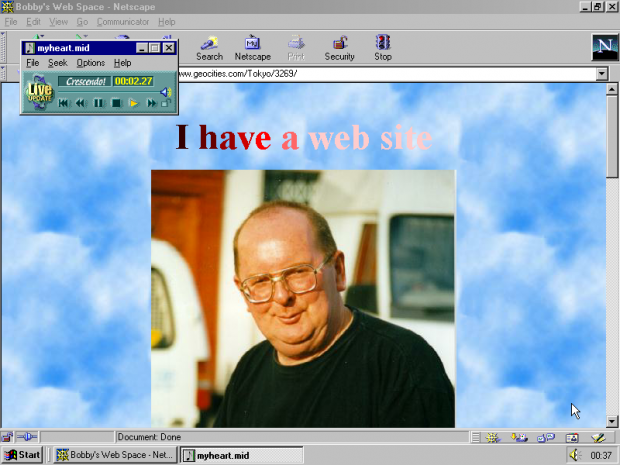 Heavy is the load of Rhizome’s digital collection. Its new archivist, Dragan Espenschied, is now tasked with updating and maintaining Rhizome’s ArtBase, the museum’s collection of over 2,500 digital artworks. The task is little like collecting waves; each Internet-born artwork poses a unique set of problems, prone to break or change with each social media and software update. How do you preserve a piece which was made for a defunct social media network? How do you restore a broken twenty-year-old artwork that you’ve never seen before?
Heavy is the load of Rhizome’s digital collection. Its new archivist, Dragan Espenschied, is now tasked with updating and maintaining Rhizome’s ArtBase, the museum’s collection of over 2,500 digital artworks. The task is little like collecting waves; each Internet-born artwork poses a unique set of problems, prone to break or change with each social media and software update. How do you preserve a piece which was made for a defunct social media network? How do you restore a broken twenty-year-old artwork that you’ve never seen before?
These may not be such daunting prospects for Espenschied, who’s been known to take on Herculean archiving challenges. Back in 2009, Jason Scott, with a group of people calling themselves the Archive Team, rescue-torrented millions of user profiles from the personal webhosting service Geocities, which was shut down soon after Yahoo bought it. Espenschied and Olia Lialina repaired the torrent (one of the largest ever) and have been contextualizing Geocities culture and history on the Tumblr One Terabyte of Kilobyte Age– which posts a new Geocities profile screen grab every 20 minutes.
I talk with Espenschied about how to preserve digital artworks, which were made for an inherently slippery platform.
Whitney Kimball: So I read on Wikipedia that you started programming for Atari in 1991. You must have been a teenager at the time, right? What were you doing?
Dragan Espenschied: My friends and I wrote a screensaver! [Laughs.] Which was better than After Dark, I think, technically, which was the dominant [computer screensaver software] on Macintosh at the time. We were on this Atari platform which was very popular, and had basically used the same internal technology as Macs, but was much cheaper.
WK: How did you learn to program?
DE: At the time, that was quite natural. If you had a computer, access to software was very limited. So you had to know somebody who knows somebody who has this program you want, because there was no Internet. Or you had to make your own software. So a lot of people in my generation got into this like that.
If you bought a computer at this point, it would usually come with a programming language that you could just do something with. Even Macs came with HyperCard, which was Apple’s idea of how people would make their own software.
WK: What’s a day in digital archiving like on the ArtBase? Does that take up most of your time?
DE: That takes up all of my time, yes. We’re just about to nail down a strategy for how to deal with the ArtBase.
But from working with other collections, you understand that the most interesting collections of born-digital artifacts are mostly in the hands of organizations that are also born-digital [ed note: transmediale, Ars Electronica, netart_latino, turbulence]. Whereas a big museum [ed: the Whitney] would typically pick just a few pieces, born-digital organizations would usually, at some point in their existence, have had an open submission process. So they usually have huge collections. And at the same time, they have lots of other things to do; it is always a challenge to handle the scale.
WK: So does restoration of digital artworks mostly involve fixing broken MIDIs, updating missing elements?
DE: Well, there are different approaches. First we have to assess what is broken, what’s can be considered broken, or what is the definition of broken, actually. [Laughs.] Sometimes with some digital artifacts, it is quite easy to assess: there is a CD-ROM, you put it in a computer, something nice happens, and you think, Oh well, this works.
But if you encounter something that you had never seen when it was made, some Internet piece from ‘94 or something, it is very difficult to understand what the system environment was, what the network environment was at this point, what software was used to create it, or what software was used to look at it. You can say, Oh yeah, something happens, but I’m not sure if it’s what used to happen, or if it’s even important what used to happen in ‘94 when I looked at this file. It’s also possible that this file was made to look different each time.
And with Internet-based artists, the work has potentially unlimited contexts. The very nature of social media, for example, is to decontextualize everything and put it back together in all kinds of ways. For each user, it will look different. And since these services gain so much importance in digital culture now, of course digital artists use them. It would be a big disappointment if they wouldn’t. So this is really about constantly adapting the strategy and describing qualities that are important.
WK: What’s an example of an artwork which includes neverending links and you’re unsure of whether they’re [the same]?

Screenshot of Heath Bunting’s “Own, Be Owned, or Remain Invisible” (http://www.irational.org/heath/_readme.html)
DE: There is Heath Bunting’s Own or Be Owned, or Remain Invisible, which is a very early web art piece. It’s an article about himself which he took from a newspaper, and he links every word of the article to the dotcom domain of this word. So there would be and.com, you.com, and so forth. It’s really about each time you revisit this work, you understand what has been commercialized in the language. It makes use of the core feature of the web, but it has been one of the most stable works.
And then, for example, it would be a mistake to not try to find what was the state of you.com when this work was created. Not much to do, in this case.
WK: So what are some ways that you anticipate dealing with Facebook? If Facebook dies, would you think about replicating a Facebook environment for a Facebook-native piece to be seen?
DE: It is a Herculean task. Before this really can be addressed on a level where you can say this actually works, it has to be put into the hands of a really really powerful institution. But most institutions that have the power are not ready to do this at all. The role of born-digital institutions is really to establish ways to deal with such problems, or to make examples—just to experiment, to see what works and what has potential.
There are some technical things that you could do, and if it’s cleverly thought-out, might benefit a lot of artworks. So if you, for example, managed to kind of freeze Google maps in time, or give the artwork something that looks like Google maps and behaves like Google maps, you might be able to have 50 artworks that use this and suddenly, they work again. So that would be quite a big benefit.
WK: Do you think that giant corporations would be willing to freeze or make a copy of their program just for a museum?
DE: No. The experience until now…has been extremely bad. The exception is Microsoft, because I think they are the legacy company of the planet. [Laughs]
WK: Why?
DE: Well I don’t know how long they’ve supported the Windows XP. I think they’re kind of heroes when it comes to this. And in another project we’ve been working with, they’ve been granting licenses to use Windows 98 or something. You have a license for Windows 7? Here’s your Windows 98 key, just never call us about this again. We can’t give you technical support, but, have it.
I think they have a duty to archive software and make it available to the public after a period of several years. But in the end, the technical problems are not so hard as the legal ones—the legal system is much more difficult to manipulate, and the technical environment is actually very easy to manipulate.
That’s also why I’m very interested in the archiving of digital culture, because it is so ahistoric.
WK: Speaking of ahistoricism—you and Olia Lialina have said that when Yahoo shut down Geocities, Internet users lost a major creative outlet. Where did Geocities users go, and why do you think so many users shut down their pages before Yahoo did?
DE: Really, it was regarded as something of a natural process…but actually so many users deleted their Geocities pages because they were made to feel ashamed.
WK: Really!
DE: Yeah, it was such a hating culture. Many factors contributed to it– Olia’s written about that. When web design became a profession–
WK: –suddenly, everyone’s an amateur.
DE: Yeah. It was clear that there had to be an opponent. They started shaming communities, finding like the nastiest-looking homepage that was made by some grandmother or teenagers and say oh this looks so bad, it has all this animation and rainbow gradients…there are still communities that do that, by the way.
WK: What are some of the specific elements of Web 2.0 design that limits creative expression?
DE: Well, it happens so often that users are made to be excited about the same things over and over again. You can export a PDF. It’s amazing!You have a keyboard that doesn’t suck! I had keyboards that didn’t suck in the eighties. It was great. And this is not a technical problem, this is a cultural problem.
WK: Yeah, there’s exportaPDF.com…
DE: [Laughs] Yes! It’s very foolish to move into that direction, I think, because it’s just basic stuff that has been working forever. You have to constantly re-learn the same skills over again because the service might be bought by Yahoo, and Yahoo will close it after one year….
Geocities users really had the possibility to take elements and recombine them, to take standard elements that would be a kind of language, like an alphabet, and put them together. And then put an animation of a cat on top of it, and you think, well, the cat doesn’t make sense in this space, and somehow that’s the most normal thing you can think of. And so, they talk like this. Social media doesn’t give you this freedom; it only lets you talk in the predefined media: upload a photo, a visit, post a link.
WK: Like the modular web…
DE: Yeah but it is modular from the logic of the social network.
I want to see a Twitter post with this hashtag. Or on Facebook, you’ll find a lot of communication in the same frequency– “I want to see this movie at this time with this person”, or they paid two dollars so you see this message.
Because the system can just switch the design, the narrative can be switched to something completely different. What you see a lot on Facebook, for example, is that text is presented as an image. You wonder, why do they not post it as text? It’s because when it’s a screenshot, it’s not so easy to rip it apart. And the system can’t, you know, index it and put it in a different context.
Users have no way to make any combinations. So to them, they lost the narrative power over their spaces.
WK: Something I’ve noticed about the Geocities pages, which you don’t see anywhere is that, like the URLS which mimicked a physical address, people had a sense of ownership over the space—this is my room, Danny’s area…
DE: Yeah, my castle. Most of them were “my homepage.” My favorite page, very early on, made up a story about a king who gives you a passport to his kingdom [to enter the site]. So it was an extremely close relationship between the medium and the users. Extremely close because they understood that they are building an endless network, and with everything they put online, they increase this space. With most social media users on Facebook, of course, they kind of see it [Facebook] as an opponent they just have to deal with if they want to talk to other users.
WK: Have you rediscovered any great old works in the ArtBase that you think people should look at again?
DE: Yeah. To me, it’s just rolling in the golden coins. And because there’s a distance to it, it’s more easy to get involved with, actually.
For example, some artworks which I would have thought of as pompous before (like Baroque installations) I can enjoy more now—like when those bonbon iMacs came out or technical installations that used to get lots of corporate sponsorship. You would look at it and say, Oh they just want to overwhelm me, but they won’t overwhelm me, I’m too smart for you! But when you come back in a few years, it’s impossible to overwhelm you with this old crap. You can experience the art again.
What really strikes me is this repetition in digital artifacts. I saw an app art exhibition for apps on mobile devices or touch devices. The work uses exactly the same narrative techniques or interaction techniques as CD-ROM art did in the mid-nineties. But many computers don’t have a CD slot anymore, so that work is totally gone—from the minds of the art audience and the critics.
WK: Is there any way to reconstruct what was on there?
DE: Well the transmediale festival in Germany has a collection of 300 CD-ROM art pieces. And we made a mass restoration with the University of Frieburg. You couldn’t access all of them again, but hundreds. It’s still not public, but these are really things that need to be public, so you can think about historical lines or styles, or…anything. Otherwise digital art—it’s missing its own reference points. It can have a life of its own, but only if it’s historicized.




Comments on this entry are closed.